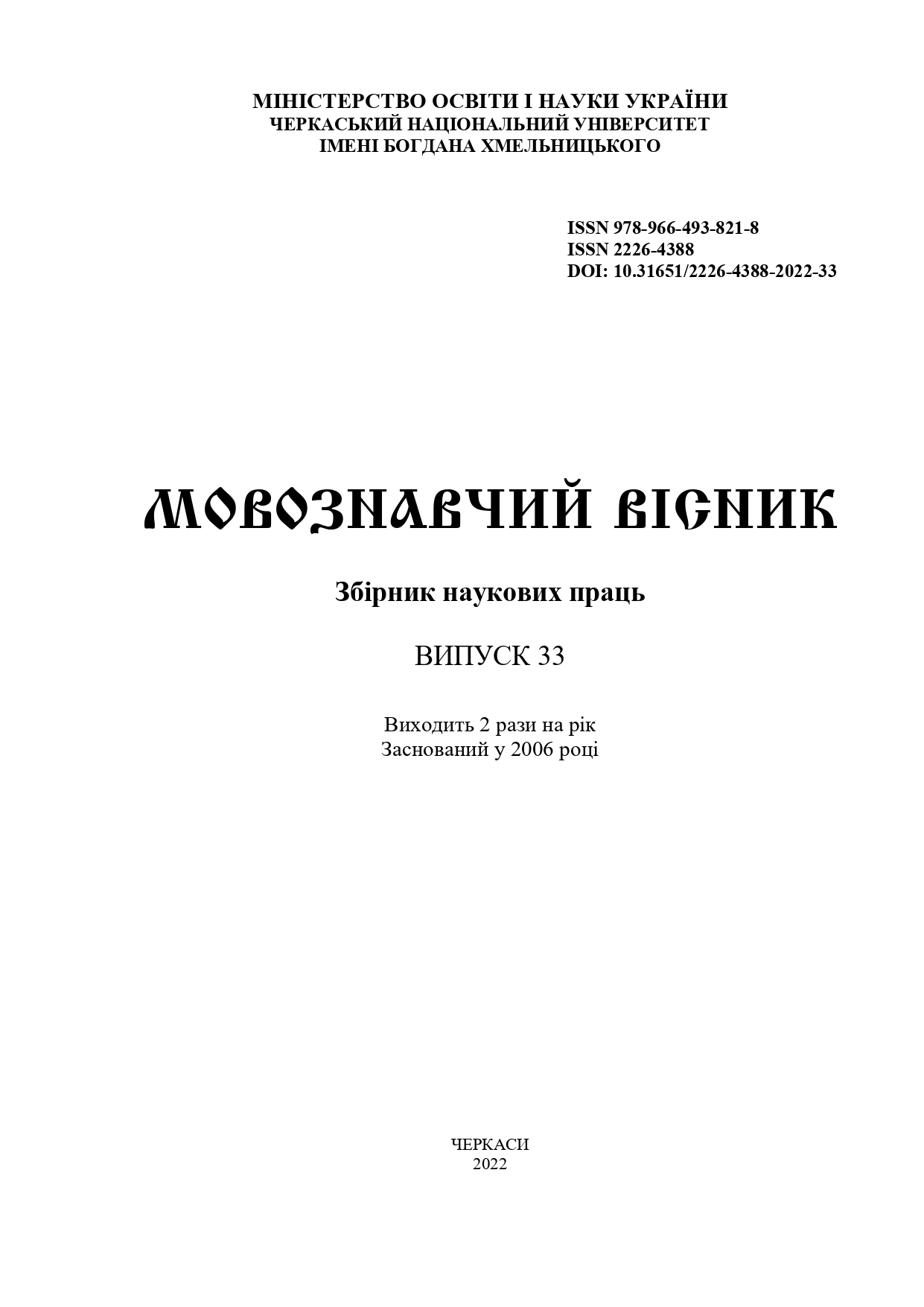CLUSTER ASPECTUAL PARTNERSHIP IN THE ASPECTUAL SYSTEM OF THE UKRAINIAN VERBS
Main Article Content
Abstract
Introduction. In the article, the concept of Laura Yanda was developed, in particular the inclusion of the material of imperfective aspectual partnership, which made it possible to conclude that any poly-semantic verb (and verbs are mostly poly-semantic) is potentially a species cluster, that is, a integration of at least three aspectually interconnected, but different aspectual status and aspectual behavior of the
lexical-semantic variant of the verb. Attention focus on antinomies applying to different ways of expressing the
aspectual semantics of verbs (lexical, grammatical and derivational), as well as on rules regulating the use of
perfective and imperfective verbs and the inventory of forms that implement the rules.
Рurpose. Since in Ukrainian linguistic studies the problem of aspectual clusters has remained outside the attention of researchers, there is a need to start a linguistic study of cluster aspectual partnership and therefore the purpose of the article is to expand the scope of the concept of «aspectual cluster», to prove the potential openness of the verb to cluster partnership, and to establish a typology of
aspectual clusters in the aspectual system of modern Ukrainian language.
Methods. Complex aspectual diagnostics as integrating methods that presume motivated application of logical, component, word-building, oppositional and distributive analyses, selection of native correlative discourse samples etc.
Results. The study of cluster aspectual partnership on the material of verbs of the imperfect form with diffuse semantics and their perfective correlatives makes it possible to distinguish five types of aspectual clusters.
Originality. The development of Laura Yanda’s concept in particular the inclusion of the material of imperfective aspectual partners enables the conclusion that any poly-semantic verb (and verbs are mostly poly-semantic) is potentially a aspectual cluster, that is, a integration of at least three aspectually interconnected, but different in aspectual status and aspectual the behavior of the lexical-semantic variant of the verb, which can have the following main manifestations: 1) polycategorical cluster as a
integration of imperfective-correlative es and imperfective-isolative; 2) poly-prefix cluster as a integration of imperfective-correlative and multi-prefix perfective-correlative; 3) bi-imperfective cluster as a integration of prefixless and prefixed imperfective-correlative with a common perfective-correlative (traditional «aspectual threes»); 4) perfective-suppletive cluster as a integration of the imperfectivecorrelative on the one hand with the prefix perfective-correlative, and on the other with the perfectivesuppletive; 5) combined cluster as a integration of two or more of the above clusters.
Conclusion. Further study of aspectual clusters involves the expansion of this concept to «aspectual clusters», which include not only aspectual partners (according to Laura Yanda's concept, natural perfectives), but also action partners (partners by gender, or modes of verb action), which, according to the mentioned concept, belong to complex and singular perfectives). Our study confirms the
need to distinguish between lexical and grammatical limits of action in a theory of Slavic aspect. It is also very important to preserve the concept of aspectual pair, which is of central importance to organize verbal paradigms in terms of aspect in all the modern Slavic languages.
Article Details
References
Vendler, Z. (1957). Verbs and times. In : The Philosophical Review. 66, 143–160 (in Еng.).
Janda, L. A. (2007). Aspectual Clusters of Russian verbs. In: Studies in Language, 31/3, 607–648 (in Еng.).
Janda, L. A. & Korba, J. ( 2008). Beyond the pair: Aspectual clusters for learners of Russian. In: Slavic
and East European Journal, 52, 254–270 (in Еng.).
Janda, L. A., & Lyashevskaya, O. (2011). Aspectual pairs in the Russian National Corpus. In: ScandoSlavica, 57, 2, 201–215 (in Еng.).
Janda, L. A. & Lyashevskaya, O. (2011). Prefix variation as a challenge to Russian aspectual pairs: are
завязнуть and увязнуть ‘get stuck’ the same or different? In: Russian Linguistics, 35, 2, 147–167 (in Еng.).
Janda, L. A. (2012). Russkiye pristavki kak sistema glagolnykh klassifikatorov [Russian prefixes as a
system of verb classifiers]. In: Voprosy yazykoznaniya [Questions of linguistics], 6, 3–47 (in Russ.).
Janda, L. A., Endresen, A., Kuznetsova, J., Lyashevskaya, O., Makarova, A., Nesset, T. & Sokolova, S.
(2013). Why Russian aspectual prefixes aren’t empty. Prefixes as verb classifiers. Bloomington: Slavica Publishers
Indiana University, 222 (in Еng.).
Vey, M. (1952). Les préverbes ‘vides’ en tcèque moderne. In : Revue des édudes slaves, 29, 82–107 (in Fre.).
Kalko, M. I. (2013). Aspektualnist: katehoryzatsiya, klasyfikatsiya i reprezentatsiya v suchasniy
ukrayinskiy literaturniy movi [Aspectuality: categorization, classification and representation in the modern
Ukrainian literary language]: monohrafiia. Cherkasy: Publisher Yu. Chabanenko, 487 (in Ukr.).
Sokolova, S. O. (2003). Prefiksalnyy slovotvir diyesliv u suchasniy ukrayinskiy movi [Prefix word
formation of verbs in the modern Ukrainian language]. Kyiv : Naukova dumka, 284 (in Ukr.).
Yasai, L. (1997). O printsipakh vydeleniya vidovoy pary v russkom yazyke [On the principles of
identifying a species pair in Russian]. In: Voprosy yazykoznaniya [Questions of linguistics], 4, 70–84 (in Russ.).

